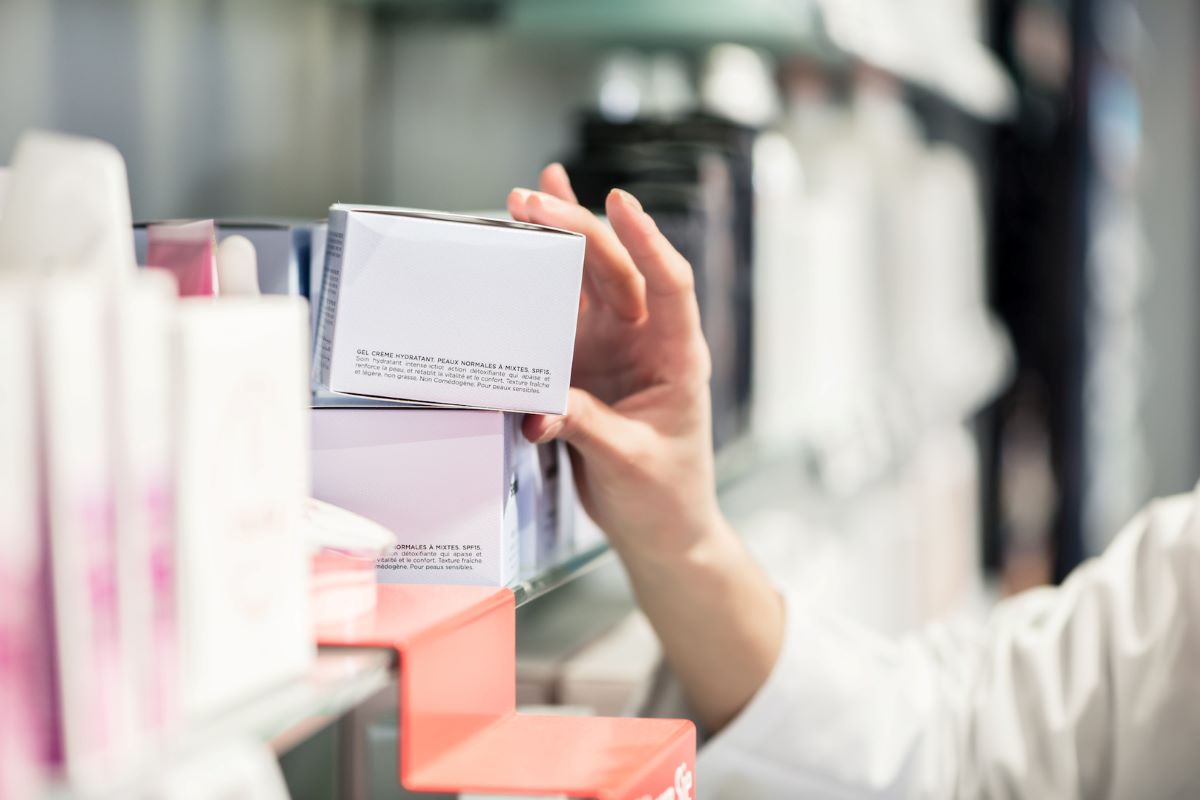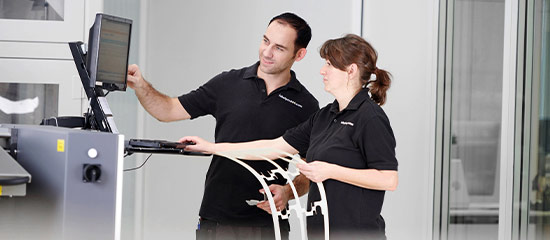 (1).jpg)
Basic knowledge: what is secondary packaging?
- More protection for primary packaging: With secondary packaging, many primary packaging materials can be even better protected.
- More space for marketing: As outer packaging, secondary packaging offers plenty of space for promotionally effective designs.
- More information for greater safety: outer packaging provides important information to ensure that customers use their purchases safely and correctly.

As far as direct contact with the product is concerned, secondary packaging really does take a back seat. But this does not make them any less important: they serve as additional protection for primary packaging and packaged goods, play a central role in shipping and are also indispensable in marketing. Reasons enough to take a closer look at secondary packaging.
Primary packaging vs. secondary packaging
Unlike primary packaging, secondary packaging does not come into contact with the product. Rather, it represents the second packaging level - packaging for the packaging, so to speak.
DAt first glance, this sounds a bit paradoxical, since primary packaging materials must already take over the protective function for the packaged contents. To do this, however, they themselves must remain undamaged. However, many primary packaging materials are too fragile or unwieldy for transport - beverage bottles, for example, can break or plastic tubes can be crushed.
Repackaging is therefore indispensable in many cases. This applies to the improved protection as well as to the better marketing opportunities.
The requirements for secondary packaging
Secondary packaging is used for different purposes and the requirements vary accordingly. However, some basic tasks are always included, especially the protective and promotional functions.
The central requirements can therefore be summarised as follows:
- Secondary packaging should be strong enough to protect the primary packaging and its contents
- They should also be easy to design because they serve as additional "advertising space" in customer contact.
- Two aspects are particularly important for the shape: firstly, sufficient space, to accommodate the primary packaging (without leaving too much unnecessary empty space). Secondly, it is a good idea to make the secondary packaging stackable -especially if this is not the case for the primary packaging.
In terms of the required properties, several overlaps with primary and tertiary packaging can be seen. For example, design and marketing also play a role for primary packaging, while logistical factors (stackability, best possible use of storage and transport capacities) are important for tertiary packaging. Secondary packaging therefore literally lies in between and must meet requirements from both areas.
According to the Fraunhofer Institute for Material Flow and Logistics IML, primary packaging is considered sales packaging - at least from the customer's perspective - because it is regarded as a sales unit. However, the term "sales packaging" can also be found for secondary packaging.
Both are possible. It ultimately depends on whether the primary packaging still needs an outer packaging. If this is the case, this second layer of packaging is considered a sales unit.
Secondary packaging - real advertising professionals
One of the most important tasks of secondary packaging is to add extra value to products in primary packaging. This is particularly interesting when these are intended for the retail trade. Because then it is important to attract the attention of customers at the point of sale.
But the marketing function encompasses more than this obvious level. Because secondary packaging not only influences customers' purchasing decisions, it also contributes to customer loyalty and customer satisfaction in a variety of ways.
Step #1: "May I have your attention?"
Marketing is about attracting positive attention. This is not so easy for retailers with many products because the competition is very high. In such competition, secondary packaging - especially folding boxes and hinged lid boxes, but also other forms such as counter displays – offer some advantages. In online retailing, this applies in the same way to shipping cartons.
- More space for advertising messages
Repackaging provides a considerably larger advertising space. Boxes and cartons can be fully printed and designed. This creates wide-ranging opportunities to bring unique designs to customers and grab their attention.
- More space for branding
Attention is one thing, recognition is another. The additional space of the secondary packaging lends itself to presenting not only the product but also the brand and the image associated with it.
To make the best possible use of the advertising space gained, outer packaging made of cardboard or carton is particularly well suited. They can be excellently printed and finished. The best prerequisites for individual marketing that suits the product and brand.
Because the visual design of the packaging is not an end in itself but serves to communicate with the customer. Addressing the target group. must therefore be taken into account in all design elements, from colour to typography.

Step #2: More wow effect with unboxing
Opening the packaging should feel a bit like Christmas or a birthday. Folding boxes and cardboard boxes with hinged lids are particularly suitable for this - the association with a gift is given right from the start.
A holistic concept for secondary packaging enhances the positive sensations when unpacking. This includes, for example, printing on the inside and outside, to showcase the product even better. The packaging thus even becomes an instrument for real storytelling: building excitement through the exterior design, fulfilling wishes with the design inside.
Diese Möglichkeit besteht übrigens nicht nur bei Sekundärverpackungen für den stationären Einzelhandel. Sie funktioniert genauso im Onlinehandel. Da hier die Vorfreude durch das Warten auf die Paketsendung noch größer ist, spielt das Unboxing eine umso größere Rolle.
Step #3: "How does this open?"
Unboxing is not only about presentation and appearance. Nobody likes to spend a lot of time opening a box or a package.
Of course, it must be ensured that the sales packaging is securely closed until it is opened. At the same time, there must be no moments of frustration when customers try to open the packaging. A positive brand experience therefore also includes the handling of the respective packaging.
Folding cartons, hinged-lid cartons, cardboard cans and many other secondary packaging, therefore, combine sufficient stability and secure closure mechanisms with easy handling. This guarantees the required protection, while unpacking is no problem.
The rules of the EU Falsified Medicines Directive (Directive 2011/62/EU) apply to secondary packaging of medicines. It prescribes certain safety features throughout Europe to protect intermediaries, pharmacies and consumers from counterfeit medicines.
The precautions include
- the EU-wide logo for labelling legal mail-order and online pharmacies,
- the product code (= central pharmaceutical number) to identify the medicine,
- the serial number,
- the batch designation and
- the expiry date.
The packaging itself should also be equipped with protective devices, such as a first-opening protection or tamper-evident closure, adhesive dots, seals or similar measures.
In this way, outer packaging for pharmaceutical products contributes to consumer safety at the same time.
Efficient and stable in all situations
Secondary packaging materials also have an important protective function as a second layer of packaging Because good looks alone are not enough in this respect, practical aspects are what count here. The requirements are usually less stringent than for primary packaging, because the product is already well protected - but the secondary packaging ensures that it stays that way.
To achieve this, the outer packaging must have some of the properties that we have already briefly touched on above.
Stable on the road
In order to adequately fulfil the protective function, secondary packaging must have sufficient stability - especially for transport and storage. Here, the outer packaging protects against the consequences of knocks and falls, among other things, and withstands them pressure as soon as goods are stacked on top of each other.
Secondary packaging for wine bottles, spirits or medicines in vials, jars and glasses, for example, prevents the containers from breaking. But this is only one of many possible examples. Secondary packaging is available in a wide variety of forms, depending on the intended use and special requirements.
While a solid box made of corrugated cardboard provides sufficient protection for many products during shipping, other cases require the use of waterproof plastic packaging. The solutions for secondary packaging are therefore very diverse and range from simple plastic film to foam inlays.

More efficiency for logistics
Secondary packaging makes a lot of things easier for logistics. This applies to transport as well as to storage:
- They make non-stackable products or primary packaging easier to store.
- At the same time, this enables a higher utilisation of storage and transport capacities. Pallets can be loaded much better with the help of outer packaging. The same applies to shipping crates that hold large numbers of sales units - repackaging in turn allows the size of the tertiary packaging to be calculated precisely.
- Secondary packaging is usually made of materials that have an excellent ratio of protective function to weight. This means that they only account for a small proportion of the load capacity during transport. Ideally, this means more cargo per trip without the packaging having an impact on fuel consumption, for example.
The choice of materials is less extensive than for primary packaging, not least because of the logistical demands. Cardboard and corrugated cardboard in particular meet the requirements for stability, stackability and efficiency. Plastics can be used in various forms as secondary packaging, for example as film or tray inserts.
For inlays, more and more solutions are coming onto the market that work with organic materials Instead of foams, for example, inserts made of mushrooms are used here. The classic secondary packaging, however, is used as outer packaging - and materials that are also well suited for marketing purposes are best suited for this.
These articles might also interest you:
.jpeg)
The printing industry under pressure - opportunities and risks of the Corona crisis
Since January 2020, COVID-19 has determined events in all areas of life worldwide. The rapid spread of the virus across the globe prompted the World Health Organisation (WHO) to classify the situation as a pandemic as early as March 2020.
.jpg)
Packaging materials in focus: Corrugated cardboard
The first patent for fluted paper was granted in 1856. It was applied for by the two Britons Edward Charles Healey and Edward Ellis Allen. However, they had no intention of initiating a revolution in packaging technology. Instead, their aim was to develop sweatbands for hats.

Customised packaging
These are individually manufactured packages such as folding boxes, shipping cartons or laminate tubes. Thanks to the individual adaptation to the size, weight and nature of the packaged goods, space and money can be saved.








 Roll labels request form
Roll labels request form  Booklet labels request form
Booklet labels request form  Folding boxes request form
Folding boxes request form  Custom made shipping boxes request form
Custom made shipping boxes request form  Package leaflets request form
Package leaflets request form  Laminate tubes request form
Laminate tubes request form 



















